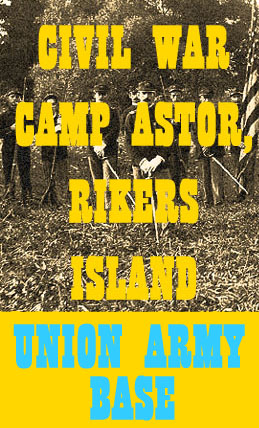
 |  |
[Continued from Page 44:]
but if it cannot be supplied by cisterns receiving the water from the roofs, it may be
furnished by a water-boat . . . .
It would seem that the best policy and best economy would recommend the construction
of a suitable prison on Riker’s Island for the reception of at least 1,000 prisoners with
barracks for a suitable guard . . . .
Very respectfully, your obedient servant,
UNION ARMY UNITS AND INDIVIDUALS ON RIKER'S ISLAND
[No record has been found establishing "Camp
Astor" as the official name of the Riker’s Island post. [However it
appears that Col. Riker or members of his regiment (as reported in a
July 19, 1861 New York Herald article) gave the name in rcognition of
the financial contribution to the organizing of the 62nd Regiment by
John Jacob Astor II, grandson of the immigrant fur trader, real estate
tycoon. financier, and philanthropist.
[In addition to Astor II's benefaction, the
regiment’s Zouave uniforms were provided by the "Ladies of the
Astor Library.”
[Riker and Astor II were about the same age, they
may have been classmates in then Columbia College, both were
attorneys, and both were colonels, Astor II on the staff of General
McClellan.
[It appears that the "Camp Astor" name was unofficial and
applied only while the 62nd Regiment was on the island.
[This name for the Riker’s Island installation also appeared in a notice in the 8/22/1861 issue of the
New York Tribune, based upon Col. Riker’s orders of the previous day to his regiment.
[Another occurrence of the name has been found.is a two-day pass titled ”Camp
Astor Rikers Island August 17, 1861” issued by the lieutenant of the 62nd’s Company E
to a Private James Schermerhorn.
[The original pass was offered for sale in 11/2003 by
“War Between the States Memorabilia,” P.O.Box 3965, Gettysburg, PA 17325.]
[John Lafayette Riker had enrolled as colonel in April, 1861, at Saltersville, N.J., at age 39. On 5/22/1873 NY’s G.A.R. Post #62 was chartered in his name.]
[Continued on Page 46 below.]
|
[Continued from Page 45:]
Previously Mott had been a captain of artillery at the Chain Bridge fortification in Washington, D.C.
After the Civil War, Mott became -- with U.S. Army encouragement -- a major general in the army of the Khedive of Egypt (Mott is in that uniform above).
He helped to organize it into a disciplined modern force by the standards of that era. Mott's military venture in Egypt, with other former Civil War officers from both sides, is among the exploits covered by Richard Harding Davis in his non-fiction book Real Soldiers of Fortune.
About the same time, Mott's brother-in-law, Dr. William Holme Van Buren, was an attending and later a consulting surgeon at the Department of Public Charities and Correction's Charity Hospital on Blackwell’s Island (now known as Roosevelt Island).
Click the above image to visit the William Wing Loring WWW site to learn
more about this little known chapter in the history of U.S. military involvement in the Middle East. This image and caption do not appear in printed book and have been added to the web version by the NYCHS webmaster.
|
[Continued from Page 46:]
THE DRAFT RIOTS AND RIKER'S ISLAND
The draft riots of mid-July, 1863, have been blamed first on [the then] recent immigrants
who are claimed to have had no interest in the Civil War and in being drafted to
defend the integrity of the United States, and, by them, on the Negro population
which was seen as being the cause of the war and as taking their jobs if they were to
be drafted.
Accordingly, mob action was directed largely against Negro people. One
of the targets was “The Orphan Asylum for Colored Children,” on Fifth Avenue
between 43rd and 44th Streets, which housed between six and eight hundred
children.
On July 13 a mob ransacked the three and four storied building and then
repeatedly set fire to it only to be defeated by firemen until after several hours the
latter could no longer defend it.
In the meantime, or presumably by when the
ransacking began, the orphans had been led from harm’s way, and by soon after
noon they were seen proceeding slowly on 34th Street toward Seventh Avenue,
escorted by a strong police detachment.
When they reached the arsenal they were
joined by a large number of black men and women carrying a few babies and a pitiful
assortment of belongings; these people had earlier taken refuge in adjacent station
houses.
The procession then reformed and marched down 35th street to the North
River, again led by the police,. In addition a strong detachment of Hawkin’s Zouaves,
the 9th NY Volunteer Infantry Regiment, protected the flanks and a company of the
10th NY Volunteers plus a squad of police formed the rear guard.
A large crowd of rioters followed but when the procession reached the pier they were held in check by the soldiers’ fixed bayonets while the Negro orphans and adults were safely loaded on boats and carried off to the temporary haven of Riker’s Island. <<=== Previous |
home page |
USCTs |
Civil War letters | Civil War prisons |
terrorists in NYC |
|
| ||||